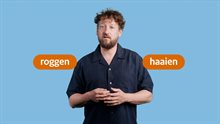Wind op Zee - Leven onder water Engelstalig

Logo: Rijksoverheid
Screen text: Wind op Zee, Leven onderwater
Translation: Offshore Wind, Life underwater
Animated fish swim past the screen text.
Presenter: "Wind... Sometimes with. Sometimes against. Our country is known for it. This wind also provides 16% of current electricity demand through our offshore wind farms. And that will even be 75% after 2032. Nice and sustainable of course! As long as we take good care of the North Sea."
A windturbine is being build at sea. A small shark and a ray are swimming over the ocean floor of the North Sea.
"Because the more wind turbines we install, the more all life in and around the North Sea will suffer the consequences.
That is why the Government, together with other partners, is continuously conducting research into the effects of wind farms on all life under water.
In this way, we are continually expanding our knowledge. Because the more we know about the effects on North Sea nature, the better we can refine our policy for wind farms, and the more effectively we can take measures to limit undesirable effects of offshore wind energy."
The presenter is standing in front of an animated background. A huge wave fills the screen and animated fish swim past.
"For example, we conduct research in the laboratory, but also on and in the sea.
Research at sea is difficult. And it is also the case that a change for the smallest animals under water can have major consequences.
Very small bottom animals or bottom plants are eaten by fish, which in turn are eaten by larger fish and marine mammals.
This can change the entire food web."
A seal swims past. At the beach, a whole network of cables is laid out to provide wind turbines with electricity.
"Of the wind farms, only the rotating wind turbines are visible, but under water, a web of cables brings all the generated energy to land.
Electromagnetic fields are created around these cables. It is possible that some fish, such as sharks and rays, suffer from this.
They have a special sense that could confuse these electromagnetic signals from cables with natural signals from a prey or partner.
Research should provide more clarity on this. Some marine mammals can be affected by the underwater noise when piling foundations.
Without measures, this can lead to major effects on marine mammals. We therefore set limits on underwater noise during pile-driving activities.
Builders of wind farms must take measures to comply with the noise standard. This can be done, for example, by using screens with air bubbles or new methods of foundation construction."
A visual of the air bubble screen is being displayed. The presenter continues:
"Another example is that we are doing research on harbour porpoises to see how they behave during the construction of a wind farm and also afterwards, when the wind farm is in use."
A harbour porpoise is visible on an underwater camera.
"When developing offshore wind farms, we also take advantage of ‘opportunities’ for nature. For example, we use rockfill on the bottom around the turbines. This creates a pleasant habitat for fish to find food, mate and lay eggs. This is an example of nature-inclusive building."
Coral, crabs and starfish gather around the rockfill. An animated visual displays the Netherlands and the locations of the wind turbines.
"By investing as a society in research into nature, we are increasingly aware of how we can limit the negative effects of wind farms and stimulate positive effects. We work together with science, industry and nature organisations. And with other North Sea countries. Because marine animals know no boundaries. We also invite wind farm developers to use new technologies to better understand and save underwater life. Together we are committed to using offshore wind energy now and in the future, to disrupt the rich underwater life of the North Sea as little as possible and even give it a little helping hand here and there. This is how we keep an eye on the balance between nature and energy."
Birds gather on the seashore. A person on the beach walks towards the horizon.
"Do you also want to know more about life above water?
Then watch our other video on: windopzee.nl"
Screen text: Meer weten over leven boven water en ecologisch onderzoek? Kijk dan op windopzee.nl en noordzeeloket.nl/Windenergie op zee ecologisch programma (Wozep)
Translation: Want to know more about life above water and ecological research? Visit and search on windopzee.nl and noordzeeloket.nl/windenergie for sea ecological programme (Wozep)
Met dank aan: Boskalis, Blauwwind, Dutch Maritime Productions BV, TKI Offshore Energy, Tappan Communicatie, Tennet, TNO en Wageningen Marine Research voor het gebruik van beeldmateriaal.
Translation: with many thanks to: Boskalis, Blauwwind, Dutch Maritime Productions BV, TKI Offshore Energy, Tappan Communicatie, Tennet, TNO en Wageningen Marine Research for providing footage.